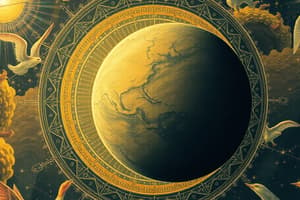Podcast
Questions and Answers
What is a characteristic of the orbits of terrestrial planets?
What is a characteristic of the orbits of terrestrial planets?
- They all have the same period.
- They are closely spaced. (correct)
- They are all elliptical.
- They are widely spaced.
Which planet has the largest mass?
Which planet has the largest mass?
- Mercury
- Uranus
- Jupiter (correct)
- Earth
What is the surface composition of jovian planets?
What is the surface composition of jovian planets?
- Rocky, solid surface, lots of silicates, iron, etc.
- Gaseous, no solid surface, mostly hydrogen and helium. (correct)
- Icy, with a crust of frozen gases.
- Liquid, with a mix of water and methane.
What is the duration of a day on Mercury?
What is the duration of a day on Mercury?
What is the effect of Mercury's slow spin on its axis?
What is the effect of Mercury's slow spin on its axis?
How does the gravity of Mercury compare to that of Earth?
How does the gravity of Mercury compare to that of Earth?
Why is Mercury unable to hold an atmosphere?
Why is Mercury unable to hold an atmosphere?
What is the source of the gases in Mercury's atmosphere?
What is the source of the gases in Mercury's atmosphere?
Why are there many impact craters on the surface of Mercury?
Why are there many impact craters on the surface of Mercury?
What is the reason for the magnetic field of Mercury being so small?
What is the reason for the magnetic field of Mercury being so small?
Why did scientists not expect to find a magnetic field around Mercury?
Why did scientists not expect to find a magnetic field around Mercury?
What percentage of Earth's magnetic field is Mercury's magnetic field?
What percentage of Earth's magnetic field is Mercury's magnetic field?
Flashcards are hidden until you start studying
Study Notes
Comparing Terrestrial and Jovian Planets
- Terrestrial planets have closely spaced orbits, small mass, small radius, rocky and solid surface, high density, and few or no moons and no rings.
- Jovian planets have widely spaced orbits, very large mass, large radius, gaseous surface, low density, many moons, and rings.
Mercury as a Terrestrial Planet
- Mercury is a terrestrial planet with a rocky surface, small mass (1/20th the mass of Earth), and a small radius (slightly larger than the Moon).
- Mercury's gravity is about 0.4 (two-fifths) the gravity of Earth.
- Mercury is too small to hold an atmosphere, and the hydrogen and helium gases are captured temporarily from the Solar wind that blows by Mercury.
Orbit and Motion of Mercury
- Mercury's orbit is noticeably elliptical, and its orbit constantly shifts, never repeating the same path around the Sun.
- Mercury spins on its axis every 58.6 days, which means it spins exactly three times every two trips around the Sun.
- A day on Mercury (from noon to noon) lasts 176 Earth days (about 6 Earth months), with 3 months of daylight and 3 months of darkness.
Magnetic Field of Mercury
- Scientists did not expect to find a magnetic field around Mercury, but Mariner 10 measured a small magnetic field around Mercury, only about 1% of Earth's magnetic field.
- Despite being small and spinning slowly, Mercury has a magnetic field, which was a surprise to scientists.
Surface Features of Mercury
- The surface of Mercury is packed with many impact craters due to past meteor collisions.
- When a meteor hits Mercury, it strikes harder than any other planet due to its high orbit speed.
Studying That Suits You
Use AI to generate personalized quizzes and flashcards to suit your learning preferences.




